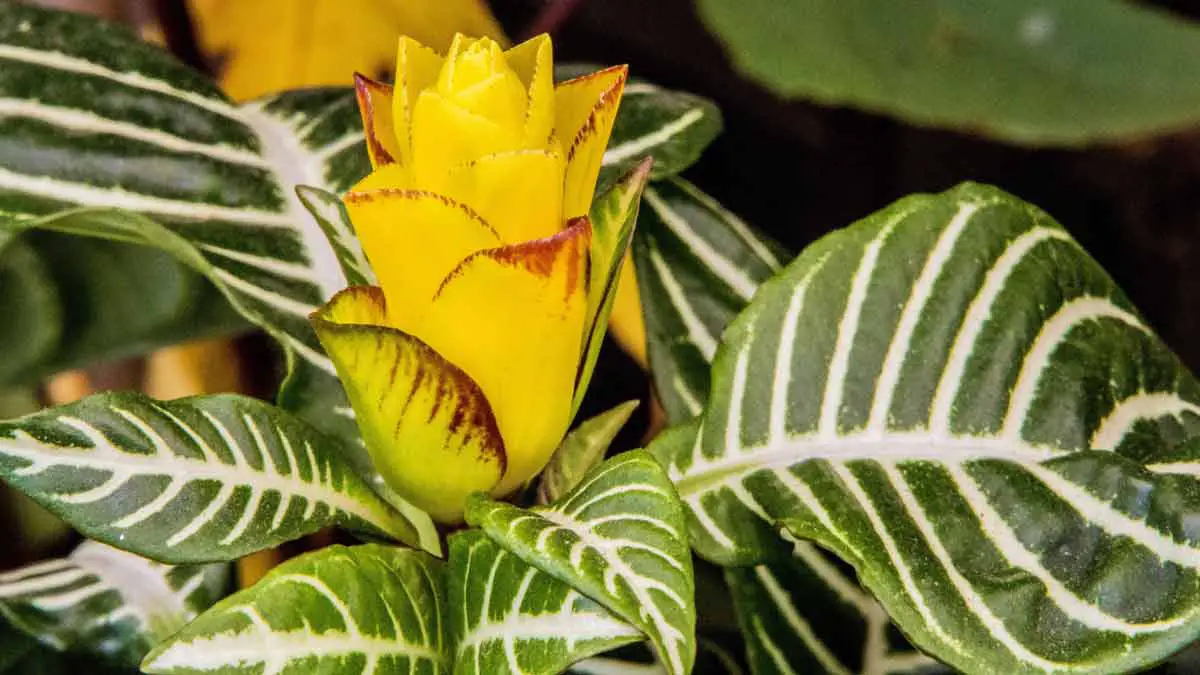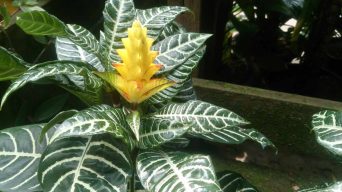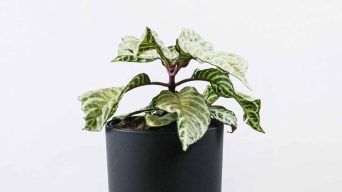Key Takeaways
- Propagating zebra plants in water is an easy and cost-effective method that promotes faster root development and provides more control over growing conditions.
- Choosing a healthy stem cutting, preparing the cutting properly, correctly setting up the propagation vessel, and caring for the cutting are important steps to ensure successful zebra plant water propagation.
- Key tips for successful zebra plant water propagation include choosing the right container with adequate drainage, providing sufficient light without direct sunlight, monitoring water level and temperature regularly, and changing the water frequently to prevent algae growth and nutrient depletion.
Are you looking to add more exotic flair to your indoor garden?
Zebra plants (Aphelandra squarrosa) are a stunning choice with their striking striped leaves and vibrant yellow flowers.
In this guide, we’ll show you how to propagate zebra plants using water – an easy, cost-effective method that leads to faster root development.
Benefits Of Propagating Zebra Plants In Water
Growing zebra plants in water has many advantages.
It is a simple and affordable method that promotes quick root development and allows for better control over the growing environment.
Easy And Cost-effective
Propagating zebra plants in water presents a budget-friendly and straightforward alternative to purchasing new plants or relying on soil-based propagation methods.
This technique allows you to expand your plant collection without putting a strain on your wallet or requiring extensive knowledge of horticulture.
One advantage of water propagation is its simplicity, making it perfect for experienced houseplant enthusiasts and novices.
By investing minimal time and resources into this process, you can quickly multiply your beloved zebra plants while gaining valuable experience in plant care techniques.
Faster Root Development
Faster root development is one of the critical benefits of propagating zebra plants in water, making it an attractive option for plant owners looking to propagate their houseplants.
This method allows not only for quicker growth but also encourages a stronger and healthier root system.
For example, rooting may take longer when using potting soil for propagation as oxygen levels are lower than in water.
In contrast, zebra plant cuttings immersed in water have direct access to oxygen and essential nutrients required for optimal root development.
More Control Over Growing Conditions
One of the greatest advantages of propagating your zebra plant in water is your increased control over its growing conditions.
Unlike potting soil, which can vary greatly in quality and consistency, water provides a clean and uniform environment for your new cutting to take root.
Furthermore, water propagation makes regulating factors such as temperature, humidity, and light exposure much easier.
Using modern gadgets like digital thermometers and hygrometers, you can place your glass jar or container in an area with suitable indirect sunlight while closely monitoring fluctuations in warmth and air moisture levels.
Step-by-Step Guide To Propagate A Zebra Plant In Water
Choose a healthy stem cutting with a few leaves to propagate a zebra plant in water.
Remove lower leaves, apply rooting hormone, and let it dry. Submerge only the stem in clean water.
Choosing A Healthy Stem Cutting
Choosing a healthy stem cutting is the first step in propagating your zebra plant.
Look for a stem about 6 inches long, with at least two nodes (where leaves grow from) and several leaves at the top.
Avoid stems that are discolored or have insect damage.
Choosing a stem that is not too young or old is also important – ideally, it should be somewhere in between.
One helpful tip is to take cuttings from new growth rather than older parts of the plant.
These will often root more easily and quickly, giving you better chances of success.
Additionally, be sure to use clean, sharp scissors or pruning shears when taking your cutting so as not to damage the stem.
Preparing The Cutting For Propagation
Before propagating your zebra plant in water, properly prepare the cutting.
Choose a healthy stem cutting with at least two leaves attached, preferably from the top of the plant.
Use clean and sharp scissors or shears to cut the stem about 4-6 inches long.
Once you have your cutting, let it sit out for a few hours to allow the wound to dry and callous over.
This will help prevent rotting once placed in water.
You can dip the stem’s end into rooting hormone powder before watering it into the vessel.
This is unnecessary but can increase your chances of successful propagation by encouraging root growth.
Setting Up The Propagation Vessel
To set up a propagation vessel for your zebra plant cutting, you will need a clean and clear glass jar or container to hold water.
The container should be large enough to accommodate the stem cutting with extra space at the top for fresh air circulation.
Fill the jar with filtered or distilled water, leaving about 2 inches of space at the top.
Avoid chlorinated tap water since it can contain chemicals that may harm your cutting and slow down root development.
You may also add a few drops of liquid fertilizer to provide essential nutrients for growth.
Once filled, place the stem cutting into the water, ensuring no leaves are submerged in water as this could lead to rotting.
Place it in a warm spot from direct sunlight and monitor regularly to ensure proper growth.
Caring For The Cutting
After preparing your cutting for propagation, it’s important to care for it properly to ensure successful growth.
Keep the cutting in a warm and humid environment with bright, indirect light.
Ensure the container or vase is clean and filled with distilled or filtered water.
It’s also important to monitor the temperature of the surrounding environment.
Zebra plants prefer warmer temperatures, around 70-80°F, so avoid placing them in overly cold areas, which could cause damage or slow down root development.
Tips For Successful Zebra Plant Water Propagation
For the successful propagation of the zebra plant, it is crucial to select an appropriate container, provide adequate light, regularly check the water levels and temperature, change the water frequently, and avoid common errors.
More detailed information can be found below.
Choosing The Right Container
The container you choose for propagating your zebra plant in water is crucial to its success.
You want a small container with at least one drainage hole, so excess water can escape and prevent rotting of the cutting.
Glass jars or vases are popular as they allow you to see the root development.
However, any small plastic or ceramic vessel will work just as well.
Just clean it thoroughly before use and sterilize it if necessary.
Additionally, consider how much light your container allows.
A clear glass jar may not provide enough shade from direct sunlight, while an opaque ceramic pot may hamper light penetration altogether.
Providing Sufficient Light
Zebra plants require bright, filtered light to thrive. However, direct sunlight can be too intense for these tropical beauties.
To provide sufficient light for your zebra plant during water propagation, ensure it is placed in an area with bright indirect sunlight.
If your home does not have a suitable spot with natural light, you can use artificial lighting sources like grow lights to provide adequate illumination.
Remember that insufficient light could lead to stunted growth and cause your plant’s leaves to lose their striking coloration.
Monitoring Water Level And Temperature
It’s important to monitor the water level and temperature when propagating zebra plants in water.
Ensure the cutting remains submerged in the water at all times, adding more as needed.
The ideal temperature for zebra plant propagation is slightly lukewarm, mimicking rainstorm variables in warmer climates.
You can achieve this by keeping your propagation vessel in a warm room or using a heating pad under the container (make sure not to let it get too hot!).
Keeping a close eye on water and temperature will help ensure your new zebra plant’s successful root development and healthy growth.
Changing The Water Regularly
Regularly changing the water in your zebra plant propagation vessel is essential for successful growth.
Changing the water every week or two prevents algae growth and ensures a steady supply of nutrients to the cutting.
In addition, keep an eye on the water level and top-up as necessary to ensure that your stem cutting never dries out.
You’ll begin seeing new root development within 2-4 weeks with proper care.
Be patient and avoid disturbing the plant too much as it acclimates to its new environment.
Avoiding Common Mistakes
To ensure successful zebra plant water propagation, it’s essential to avoid these common mistakes:
- Overwatering – While zebra plants like consistently moist soil, overwatering can cause the leaves to wilt and even lead to root rot. Check the water level regularly and only add more when necessary.
- Using a container that’s too big – Zebra plant stem cuttings need a small container with good drainage. If the container is too big, it can hold too much water and cause the cutting to rot.
- Placing in direct sunlight – Zebra plants prefer bright indirect light, but putting them in direct sunlight can burn their delicate leaves. Place the propagation vessel in a spot with bright but indirect light.
- Neglecting temperature control – The ideal room temperature for zebra plant water propagation is between 68-75 degrees Fahrenheit. Keeping the cutting in an area that’s too cold or too hot can prevent root development.
- Allowing pests to infest – Spider mites are common for zebra plants and can quickly take over if left unchecked. Use insecticidal soap or another appropriate treatment if you notice any signs of insect infestation.
By avoiding these common mistakes, you’ll have a greater chance of successfully propagating your zebra plant in water and growing healthy new plants from stem cuttings.
Troubleshooting Common Problems
If you experience stunted growth or root rot while propagating your zebra plant, there’s no need to worry.
We have some tips and solutions to help you troubleshoot these common issues and ensure your plant thrives.
Stunted Growth
It could be due to a few factors if you notice stunted growth in your zebra plant during propagation.
Firstly, make sure that you are not overwatering or underwatering the cutting.
Zebra plants prefer consistently moist soil, but too much water can cause the leaves to wilt and eventually die off.
Low humidity levels can also lead to stunted growth, as zebra plants require high humidity levels of around 60%.
Ensure that you provide adequate moisture in the air by misting the plant regularly or placing it in a terrarium-like environment with high humidity.
Finally, ensure that your plant receives enough light but not too much direct sunlight, which can also hinder its growth.
Root Rot
Root rot is a common issue with zebra plants, caused by overwatering or a lack of oxygen in the soil.
Signs of root rot include yellowing leaves, shrinking leaves, and soft or mushy roots.
To prevent further damage, it’s important to check for signs of root rot and dry out the plant before watering again.
To avoid root rot, ensure proper drainage and moisten the soil but not waterlogged.
Additionally, adding perlite or peat moss to potting mix can improve drainage while maintaining proper moisture levels for the zebra plant’s high humidity needs.
Final Thoughts
Propagating zebra plants in water is a simple and cost-effective way to expand your collection of these beautiful tropical plants.
Following the step-by-step guide outlined above and providing proper care, you can watch as new roots develop from your stem cuttings.
Remember to choose healthy cuttings, provide sufficient light, monitor water levels and temperature, and avoid common mistakes such as letting the leaves touch the water.







